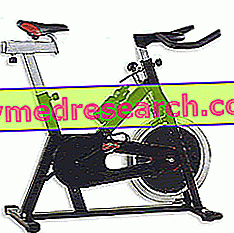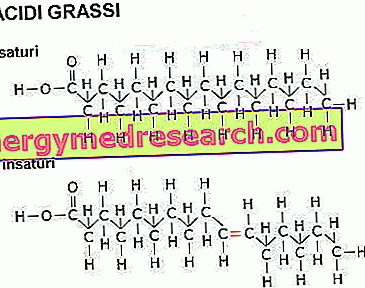Generality
Heel pain is a very annoying symptom, which afflicts people with problems such as, for example, plantar fasciitis, heel stress fractures, calcaneus bursitis, tarsal tunnel syndrome, heel spurs and inflammation Achilles tendon lesions.

Diagnosing the causes of heel pain is important for therapy planning.
Therapy, therefore, depends on the triggering factors.
The treatment can be conservative or surgical. In general, doctors prefer to resort to conservative treatment and reserve the right to intervene surgically only in extreme cases.
Brief anatomical reference to the foot: localization of the calcaneus
The anatomists divide the bones of the foot into three groups: the tarsal bones (or tarsal group), the metatarsal bones (or metatarsal group) and the phalanges.
- Tarsal bones or tarsal group or tarsus . Located just below the ankle joint, there are 7 irregularly shaped bony elements: the talo (or astragalus), the calcaneus, the navicular, the cuboid and the three cuneiforms (lateral, intermediate and medial).
- Metatarsal or metatarsal group bones or metatarsals . Belonging to the category of long bones, they are in all 5 elements, arranged parallel to each other. The proximal section is bordered by the cuneiform tarsal bones and the cuboid; the distal section, on the other hand, borders on the phalanges.
- Phalanges . There are a total of 14 and they represent the bony elements that make up the toes. Except the first finger - the only one formed by 2 phalanges - all the other fingers have 3 phalanges each.

What is heel pain?
Heel pain is an annoying sensation, which the subject feels at the level of the heel and, sometimes, in adjacent areas.
In general, it appears gradually and tends to get progressively worse over time.
They can increase the intensity, more or less momentarily, various circumstances, including: giving weight to the aching heel, walking for a long time, running or spending many hours standing.
Heel pain is a type of malaise that often characterizes morning awakening and, in general, all periods of inactivity lasting a few hours. With the resumption of movement, it tends to diminish and the person concerned feels a significant relief.
Epidemiology
Heel pain is a very common condition, which, according to some statistical surveys, would affect one person every 10 at least once in a lifetime.
The categories of individuals most at risk of heel pain are two: the category of those who practice running and or jogging regularly and the category of adults aged between 40 and 60 years.
Causes
The list of possible causes of heel pain is very long and includes:
- Plantar fasciitis, which is the most common trigger ;
- Stress fractures of the calcaneus;
- The heel bursitis;
- Tarsal tunnel syndrome;
- Sever's disease;
- The heel spur;
- Atrophy of the plantar fat pad;
- Inflammation of the Achilles tendon;
- Achilles tendon rupture;
PLANTAR FASCIITIS
Plantar fasciitis is a very annoying injury to the so - called plantar fascia .

Returning to plantar fasciitis, this injury is often the result of a combination of favoring factors; in fact, it is rarely the result of a single cause.
Its appearance can be sudden or gradual, depending on the factors favoring it.
Risk factors for heel pain:
- Old age. Aging involves a reduction in the flexibility of the plantar fascia and a thinning of the fat pad located below the heel;
- Diabetes;
- Spend many hours of the day standing;
- Inadequate physical activity (ex: over-training, inadequate heating, etc.);
- Suffering from flat foot or hollow foot.
STRAW FRACTURES TO THE CALCIUM
Stress fractures are often the consequence of mechanical stress on the affected bone or bones.
Stress fractures to the heel typically involve those who regularly practice sports such as running or jogging, which continually overload the bones of the feet and generally the lower limbs.
SOCCER BAGS
By the term " bursitis ", doctors mean the acute or chronic inflammation of a serous bursa of a joint.
The serous bags of a joint are small pockets filled with synovial fluid, whose task is to protect and reduce the potential frictions between the various joint structures (ie between ligaments, tendons, bones, etc.).
A calcaneus bursary - also known as heel bursitis or calcaneal bursitis - is an inflammation of one of the serous bursas that are part of the ankle joint.
TUNNEL TARSAL SYNDROME
Tarsal tunnel syndrome is a nerve compression syndrome.
In nerve compression syndromes, the symptoms are due to the crushing (or compression) of some specific nerves and surrounding tissues.
Going specifically to tarsal tunnel syndrome, nerve compression affects the nerves of the sole of the foot, which pass through an osteo-ligamentous structure located at the level of the ankle joint and called the tarsal tunnel .
Typically, to compress the nerves that pass through the tarsal tunnel is a cyst, formed close to the osteo-ligamentous structure mentioned above.
In addition to causing heel pain, tarsal tunnel syndrome also causes tingling and numbness in the affected foot.
CALCANEOUS PLUG
The heel spur is an osteophyte located at the level of the calcaneus.
Osteophytes are small bone spurs - similar to a rose thorn, a beak or a claw - that form along the joint edges of bones subjected to erosive and irritative processes with a chronic character.
Often associated with plantar fasciitis or problems affecting the Achilles tendon, the heel spur can be of two types, depending on the location of the osteophyte: the posterior heel spinal and the inferior heel spur.
SEVER DISEASE
Sever's disease is the most common cause of heel pain in children.
At its origin there is, very often, the greater speed with which the bones of the legs grow, during the young age, compared to the speed with which the tendons and the muscles of the thigh and the leg develop.
In fact, this difference in speed leads to a lack of proportions between the dimensions of the skeleton and the muscle-tendon apparatus of the affected areas, with consequent stretching of the heel, by the muscles and tendons of the thigh and especially the leg (NB: the tendon Achilles groups different muscles of the leg and is inserted right at the level of the heel).
ATROPHY OF THE BEARING ADHESIVE PLANTAR
The atrophy of the plantar fat pad is a condition resulting from the deterioration of the layer of adipose tissue, located below the heel bone, whose task is to absorb impact shocks with soil during a walk, a run, etc.
The subjects most at risk of atrophy of the plantar fat pad are women.
INFLAMMATION AND BREAKAGE OF THE ACRYLIC TENDON
The Achilles tendon is that structure of connective-fibrous tissue, which connects the calf muscles (the twins and the soleus) to the calcaneal bone. It is essential for walking, running and jumping.
The inflammation of the Achilles tendon is a tendonitis . At its origin, there are very often repeated microtraumas and degenerative alterations affecting the tendon structure.
The rupture of the Achilles tendon is, instead, the laceration of the tendinous structure in question.
This injury is quite serious, as it severely limits a person's motor skills. Since the healing of the damaged tendon structure is not possible, the event of rupture of the Achilles tendon necessarily requires the surgical repair of the Achilles tendon.
further CAUSES OF HEEL PAIN
Other possible factors triggering heel pain are:
- An osteomyelitis with involvement of the calcaneus. Osteomyelitis is the medical term that indicates the presence of an infection at the bone level;
- Paget's bone disease . It is a very rare condition that weakens the bones of the human skeleton. A typical symptom of this weakening is bone pain;
- Reactive arthritis . It is an inflammation of the joints of the human body, from the double nature: infectious and autoimmune. In addition to the joints, it can also affect the eyes and the urethra;
- Sarcoidosis . It is an autoimmune disease, which causes a generalized inflammatory state. Induces the appearance, in various anatomical regions, of proliferating masses, called granulomas;
- Rheumatoid arthritis . It is another type of inflammation of the joints of the human body. It has an autoimmune origin;
- Haglund's deformity . It is a particular anatomical anomaly, in the presence of which the person concerned has a sort of protuberance on the heel.
Symptoms and complications
To learn more: Heel Pain - Causes and Symptoms
The symptoms associated with heel pain vary depending on the causes, which gave rise to the painful sensation.
For example, a condition such as tarsal tunnel syndrome, in addition to heel pain, causes tingling and numbness in the affected foot; a condition like rheumatoid arthritis, on the other hand, is responsible for swelling and / or stiffness affecting the foot or ankle.
COMPLICATIONS
If it is particularly intense or not treated properly, heel pain can induce the subject to vary the walking style, to feel the pain sensation less. It is an almost automatic behavior, which over time can be very dangerous and drastically affect the quality of life. In fact, postural problems, joint problems, etc. can result from it.
WHEN TO REFER TO THE DOCTOR?
An individual suffering from heel pain should contact their doctor when:
- The affected foot is particularly painful and also prevents a simple walk;
- There are symptoms such as tingling and / or numbness in the affected foot;
- High fever is present;
- The affected foot and his ankle are stiff and swollen.
Very often, it is also essential to consult a podiatra, ie a foot disease specialist, and an orthopedist, that is a doctor who specializes in the diagnosis, treatment and prevention of pathologies of the complex system of muscles, bones, tendons, ligaments and nerves, present in the human body.
Diagnosis
For a diagnosis of heel pain and its causes, physical examination and medical history are often sufficient.
Doctors consider the use of further diagnostic tests when the patient, in addition to the pain sensation, complains of other symptoms, such as: tingling / numbness in the affected foot, high fever, stiffness and / or swelling of the foot and ankle.
The identification of the triggering causes is fundamental for the planning of an adequate therapy.
OBJECTIVE AND ANAMNESIS EXAMINATION
The physical examination is the set of diagnostic maneuvers, carried out by the doctor, to verify the presence or absence, in the patient, of signs indicative of an abnormal condition.
The anamnesis is the collection and critical study of symptoms and facts of medical interest, reported by the patient or his family members (NB: family members are involved, above all, when the patient is very small).
Treatment
Treatment of heel pain depends on at least two factors:
- The causes of the symptoms and
- The intensity of the painful sensation .
Generally, first-line therapy is conservative (or non-surgical). In fact, the use of surgery (surgical therapy ) takes place only when conservative treatment is ineffective (or has not given the hoped for benefits) and the patient still complains of an intense painful sensation.
CONSERVATIVE THERAPY
Conservative therapy for heel pain includes:
- A period of rest . Rest is essential to recover from inflammatory states, due to repeated traumas, etc. For rest, it is intended to avoid walking for a long time, running, jumping or standing several hours consecutively;
- Taking NSAIDs . NSAIDs are anti-inflammatory drugs. The doctor prescribes them with the intention of reducing the pain sensation.
The most prescribed NSAID in case of heel pain is ibuprofen.
- Applying ice on the sore heel at least 4-5 times a day. Ice packs have an incredible anti-inflammatory power. Each pack must have a minimum duration of 15 minutes and must not exceed 20 minutes;
- Stretching exercises for stretching the calf muscles and lengthening the plantar fascia. The stretching exercises are numerous and can be of great help in reducing the painful symptoms.
The doctors' advice is to consult an experienced physiotherapist, with a particular preparation in the treatment of the problems of the foot, ankle and Achilles tendon;
- The use of more appropriate shoes, which help the patient to limit the load on the heels. To know the best shoe model, it is good to contact a podiatra.
- The use of foot orthoses, which limit the load on the heels. As in the case of shoes, to know which insoles are best suited to heel pain, it is advisable to ask a podiatra for advice.
- Use of intravenous corticosteroids . Corticosteroids are very powerful and effective anti-inflammatory drugs. Their prolonged use, however, can cause various side effects, some of which are also very serious.
SURGICAL THERAPY
The type of surgical treatment varies depending on the cause triggering heel pain.
For example, surgery for heel pain due to plantar fasciitis consists of the so-called distention of the plantar fascia .
The surgery can be done by an orthopedic surgeon or a podiatric surgeon.
Statistics in hand, the category of people who undergo surgery, for heel pain, is that of professional athletes and those who practice running, jogging and similar sports regularly.
Some details on the surgical distension operation of the plantar fascia
Surgeons have the opportunity to perform surgical distension of the plantar fascia in two ways: through an "open" surgery or through an endoscopic surgery operation.
Open-air surgery is more invasive than endoscopic surgery; however, unlike the latter, it has a lower risk of damaging the nerve structures that run near the plantar fascia.
In essence, therefore, each of the two operating modes has its own advantages and disadvantages, which the patient can discuss with the surgeon, before surgery.
Prognosis
The prognosis in case of heel pain depends on the triggering factors: a pain in the heel, whose origin is a clinically insignificant cause, is more easily treatable and will have a better prognosis than a heel pain following an important cause from the clinical point of view.
Prevention
Not all conditions that can cause heel pain are preventable.
Having specified this, keeping body weight in check (thus avoiding overweight and obesity) and wearing shoes of good quality and appropriate to the activities performed are the main countermeasures, indicated by doctors, to reduce the risk of the onset of pain heel.



